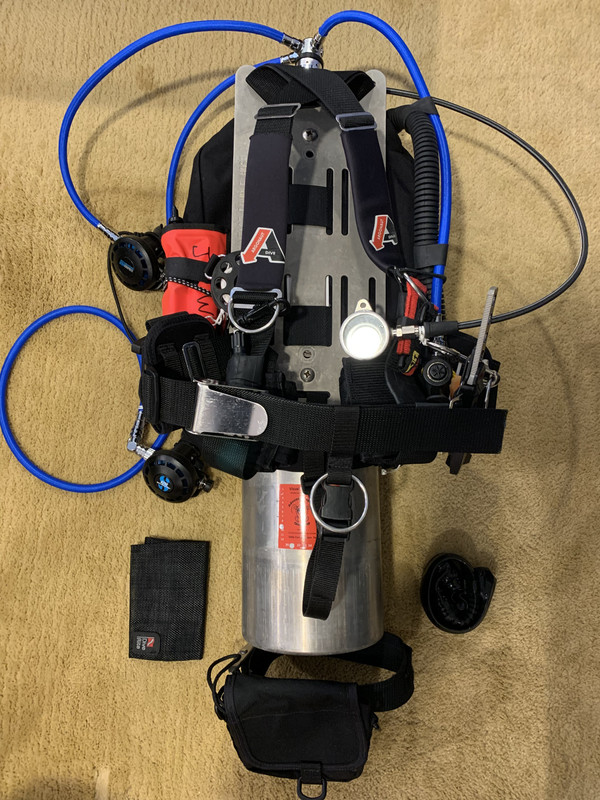bradlw
Contributor
How to know if there's enough air in it before letting go?
I have a 6ft Halcyon DSMB that I bought not long before life got in the way of my diving for a couple of decades. Never really used it.
I came from a time when a "safety sausage" for recreational divers was not the norm. I carried a small one for most of my diving, but these were a surface deployable marker, not meant to be deployed from depth
The idea of a DSMB was not even mentioned in recreational training....but being safety conscience I thought this surface marker was a good idea. This larger one seemed like an even better idea...and with the added benefit of having a lift capacity
Later, when I went through technical training, I was introduced to lift bags, and I have an open-bottomed lift bag. I was introduced to this concept and ran the training drills, but I never actually became what I'd call proficient with it .
So this DSMB that I have is a closed bottom and is filled either orally or using the LPI hose. It takes a lot of breaths to fill it, so that's not practical for anything other than a top off.
I feel like I really need to practice and experiment more with it. Really should even get some training with it. At this point I'm just trying to think it through...
It'll be easy to inflate once surfaced for use as a marker, but deploying from shallow depth is tricky.
So far, I've practiced deploying it from shallow depth, but I never got enough air in it for proper expansion at the surface.
I'm guessing that since from greater depths a small amount of gas will expand more and it'll work better, but from the shallows it seems that it would need to be filled nearly to capacity....but then I have something like 50# additional lift before letting go!
I also used it as a lift bag recently, retrieving a small boat anchor from a shallow reef (around 15-20ft)
It was very easy to get the rig to be slightly negative, then I figured that it was better to swim it up rather than try to get it neutral or positive and lose control of it....but at the surface, it was a struggle since it was still slightly negative.
In hindsight I could have let the load hang 5 or 6ft down, descend and try to puff a little more air in the inflator nozzle that's down near the bottom of the bag, but that seems like a juggle too. I did manage to blow a couple of puffs in orally but it wasn't enough...and I was close enough to the boat, and the captain lifted it aboard, so it worked out...but I'm not proud of my performance. It was a little bit sketchy
At this point I'm thinking that an open-bottomed one like this might be a better piece of kit overall.
Thoughts?
I have a 6ft Halcyon DSMB that I bought not long before life got in the way of my diving for a couple of decades. Never really used it.
I came from a time when a "safety sausage" for recreational divers was not the norm. I carried a small one for most of my diving, but these were a surface deployable marker, not meant to be deployed from depth
The idea of a DSMB was not even mentioned in recreational training....but being safety conscience I thought this surface marker was a good idea. This larger one seemed like an even better idea...and with the added benefit of having a lift capacity
Later, when I went through technical training, I was introduced to lift bags, and I have an open-bottomed lift bag. I was introduced to this concept and ran the training drills, but I never actually became what I'd call proficient with it .
So this DSMB that I have is a closed bottom and is filled either orally or using the LPI hose. It takes a lot of breaths to fill it, so that's not practical for anything other than a top off.
I feel like I really need to practice and experiment more with it. Really should even get some training with it. At this point I'm just trying to think it through...
It'll be easy to inflate once surfaced for use as a marker, but deploying from shallow depth is tricky.
So far, I've practiced deploying it from shallow depth, but I never got enough air in it for proper expansion at the surface.
I'm guessing that since from greater depths a small amount of gas will expand more and it'll work better, but from the shallows it seems that it would need to be filled nearly to capacity....but then I have something like 50# additional lift before letting go!
I also used it as a lift bag recently, retrieving a small boat anchor from a shallow reef (around 15-20ft)
It was very easy to get the rig to be slightly negative, then I figured that it was better to swim it up rather than try to get it neutral or positive and lose control of it....but at the surface, it was a struggle since it was still slightly negative.
In hindsight I could have let the load hang 5 or 6ft down, descend and try to puff a little more air in the inflator nozzle that's down near the bottom of the bag, but that seems like a juggle too. I did manage to blow a couple of puffs in orally but it wasn't enough...and I was close enough to the boat, and the captain lifted it aboard, so it worked out...but I'm not proud of my performance. It was a little bit sketchy
At this point I'm thinking that an open-bottomed one like this might be a better piece of kit overall.
Thoughts?




